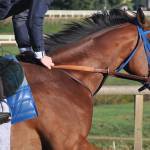Don’t Blame “Bad Step” in Racehorse Breakdowns

Catastrophic breakdowns in racehorses are most often the cumulative result of skeletal stress over a period of time, rather than the single awkward move or “bad step” that is frequently mentioned when a horse sustains a fracture during exercise. This is the conclusion reached by scientists who have performed equine necropsies at the University of Kentucky Veterinary Diagnostic Laboratory.
At a recent symposium on the prevention of injuries in racehorses, veterinarians Mary Scollay-Ward and Laura Kennedy presented information gained from five years of performing racehorse necropsies. While not ruling out the occasional equine “bad step,” similar to a human soccer or football player spraining an ankle during a game, the veterinarians said that the more likely scenario for fractures in equine lower limbs is gradual damage that builds to the point of bone failure. Weight-bearing exercise changes the shape and structure of bone, but the process takes time. A training program often makes demands more quickly than the skeleton can remodel, leading to microcracking that can seriously compromise bone strength.
Horses in training may show mild lameness, stiffness, heat, or tenderness signaling the need for a slowdown in their exercise routine. A period of rest should be followed by a very gradual return to training in order to allow the bone to develop more weight-bearing capacity. Because each horse is an individual, no single exercise routine will be perfect for every racehorse, and trainers need to assess each horse’s response to training and make the necessary adaptations.








